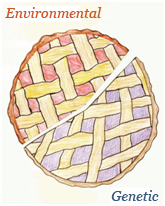Shall We Have Pie or Stew?
Posted on byUnderstanding Genetic and Environmental Causes of Human Disease
 A recent article in the Archives of General Psychiatry by Hallmayer et al. discussed the role of genetic and environmental factors in autism and autism spectrum disorders (ASD). The study was a heritability analysis of 192 pairs of twins, which attributed 37 percent of the variation in risk of autism to genetic factors and 55 percent to shared environmental factors. The authors contrasted their findings with those of previous studies, which had given genetics a much higher share (up to 90%).
A recent article in the Archives of General Psychiatry by Hallmayer et al. discussed the role of genetic and environmental factors in autism and autism spectrum disorders (ASD). The study was a heritability analysis of 192 pairs of twins, which attributed 37 percent of the variation in risk of autism to genetic factors and 55 percent to shared environmental factors. The authors contrasted their findings with those of previous studies, which had given genetics a much higher share (up to 90%).
Rather than contradicting previous research, the new results provide more evidence that autism, like many other common diseases, results from both genetic and environmental factors. The way that these elements – often called “nature and nurture” – influence health outcomes has been discussed for decades but is often misunderstood, even among scientists.
Disease Causation is Not as Easy as… Pie
Heritability analysis focuses on sources of variation in specific populations. A common misinterpretation of these types of analyses is that the causes of a particular disease are cleanly, though errantly, summed up as slices of a pie – or in pie chart fashion. For example, it is not uncommon to have the explanation of disease presented as “25 percent genetic and 75 percent environmental,” adding up to 100 percent of cases. Furthermore, from the perspective of “either/or,” a person with gene variant “X” is thought to be destined to develop colon cancer no matter what his diet, whereas a person with gene variant “Y” can smoke all she wants yet will never develop lung cancer, and so on. However, what we have learned from gene-disease association studies is that, in reality, human disease is rarely a product of such simple and clearly defined relationships. Causation of human disease is not about nature OR nurture but more about nature AND nurture.
Disease Outcomes “Stew”
Most common diseases–such as coronary heart disease, cancer, and diabetes, which affect millions of Americans–are caused by modifiable environmental risk factors such as cigarette smoking, diet, and sedentary lifestyle. Because gene-environment interactions underlie almost all human diseases, a large role for the environment does not preclude an equally large role for genetic factors. Interaction among genetic and environmental factors allows the total contribution of individual risk factors to exceed 100%.
Rather than slices of pie, perhaps we should consider another metaphor from the culinary world: vegetable stew – in which genes are represented by the many different ingredients and the environment by the time length and temperature of the cooking and whether the pot or pan used is constructed of cast iron, earthenware, or steel. Every skilled chef knows that any change in the preparation of stew, soup or similar entree can result in a completely different taste. Each cut of vegetable: carrot, tomato, onion, potato, mushroom, celery, etc and every spice could be of a different variety. Once assembled, the ingredients blend and cook together to produce a combined yet completely unique flavor. Biologic processes function in a similar way, as genes respond to a continually varying environment over time to produce various health outcomes.
Even though we may know many ways to prevent common disease through the manipulation of environmental factors, one important reason to study and understand genetic factors is that our current public health approaches to prevention have not been entirely successful. Most people do not get enough physical activity or eat a healthy diet. Many are obese or overweight, and many do not adhere to public health screening recommendations. Genetic research may help us better understand disease risks and target our environmental interventions to people who need them the most in order to best achieve public health goals with scarce resources.
Keep in mind that, in spite of having mapped the sequence of the human genome, scientists do not yet have the tools to quantify or even guess at the vast array of gene-environment interactions important to human health. In general, genetic tests that are developed and marketed to the public for predicting risk of common diseases do not account for environmental risk factors, much less for gene-environment interactions. Not surprisingly, these tests tend to have little predictive value {CDC Podcast on Personal Genomic Tests}. Genes do not define one’s destiny and public health messages which pertain to daily life decisions are as relevant today as ever before: eat a healthy diet, exercise, and don’t smoke.
Posted on by



